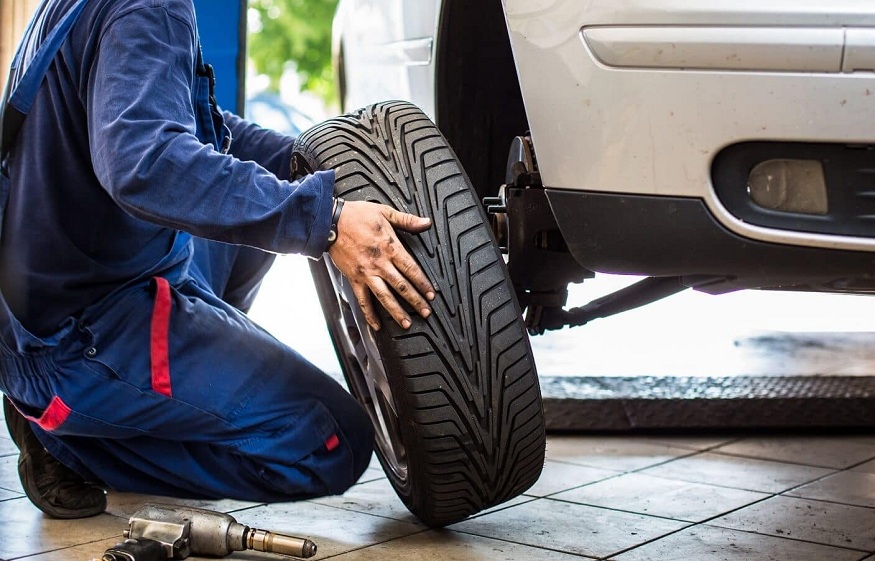Your tire is damaged? According to statistics, every motorist experiences a flat tire approximately every 150,000 km. It’s not very common, but you need to know what you can do to get mobile again quickly. In this guide, you will find out which punctures can be repaired. But also when is it worth repairing your tires and how much does a repair cost.
Why can a tire lose air?
There are several reasons why a tire can lose air. The most common cause is damage by a sharp object such as a nail or screw. Air loss can also occur if the sidewall has been damaged by a stone, for example. Another possible cause is the valve. For example, if the protective cap is missing, dirt can seep into the valve. The dirt can then prevent the valve from closing tightly during the next air pressure check. Another cause, although very rare, is a fine crack in the rim which allows air to slowly escape from the roundel. Last but not least, aging tires can lose air because the rubber has become porous.
First, if you notice a flat tire before driving off, you should leave your car, install the spare tire, or call roadside assistance. But also, if you notice the ride getting spongy while driving, you should pull over as soon as possible and check the tires. On the other hand, if one of the tires is flat, you should not continue driving. However, you can re-inflate the tire with puncture sealant so you can get to the nearest garage.
Can a puncture in a car tire be repaired?
A puncture in a car tire can be repaired relatively easily and inexpensively under certain conditions. If the hole is in the tread and is less than 6mm, you can repair a car tire. These small damages are usually caused by a driven nail or screw. Other damage, such as a crack in the sidewall of the tire or a partially detached tread, cannot and should not be repaired.
What if a nail is stuck in the tire?
If you discover a nail in the tread of a tire, you absolutely must not rip it out. Just leave the nail where it is.
If the tire has not yet lost its air, you can go directly to the nearest tire dealer or to your local garage. However, do not drive on the highway and, if possible, do not exceed 50 km/h.
If the tire loses air while driving, you should not continue driving in any case, so as not to damage it.
If it’s too far to get to a garage or the nearest tire dealer, call a towing service or the traffic club you belong to. For greater safety, you can also mount the spare wheel or, if necessary, a spare wheel. Then take the damaged tire to your garage to have it repaired or replaced.
According to traffic regulations, repair is only permitted for the small tread punctures already mentioned. Damage to tire sidewalls cannot be repaired. The so-called high-speed tires cannot be repaired either. These are tires with the speed ratings V, W and Y, which are approved for speeds of up to 240, 270 and 300 km/h. When the tread is punctured, the nylon and/or metallic fabric of the tire carcass is also always damaged. So there is a risk that these tires will burst at high speeds.
Even if you do a makeshift repair with tire sealant, you don’t have to patch a hole in the tire. Not because it is not possible, but because it is prescribed by the highway code.
Can you repair a tire yourself?
To permanently seal a hole in a tire, the tire must be removed from the rim. Repair is done from the inside, requires experience and appropriate equipment. Repair kits that promise you can easily fix the tire yourself in the garage are an emergency fix at best, but most of the time they just throw money away. They are not suitable for permanent repair.
Moreover, the question is not whether a tire can be repaired or not, but also whether it is worth repairing a tire! Should be clarified during a consultation with a specialist. Generally, a tire repair makes sense when:
If the vehicle is equipped with an Indirectly Measured Tire Pressure Monitoring System (TPMS), a repair may also make sense. With these tire pressure monitoring systems, the wheel circumferences on both sides of the axles should be as equal as possible.
If you are only replacing one tire, the differences in circumference between the new and old tires can cause problems. Therefore, on vehicles equipped with these tire pressure monitoring systems, a repair may be worthwhile.
Otherwise, on most vehicles, both tires on the same axle would have to be replaced. On some vehicles and 4×4s, it may even be necessary to replace all the tires . Either way, consult a professional for advice.
How long does it take to repair a tire?
First, the tire is removed from the rim and the damage is inspected from the inside. If the damage is repairable, the damaged area is cleaned, slightly widened if necessary and the edges are smoothed. A rubber plug can then be inserted, which is firmly bonded to the rest of the tire using a vulcanizing agent. Depending on the process, the plug is cold or hot vulcanized. After vulcanization is complete, the tire can be remounted on the rim and the entire wheel rebalanced before being mounted on the vehicle. A tire repair in a specialist workshop takes about 2 hours in total.

